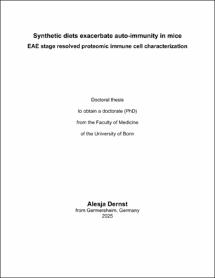Dernst, Alesja: Synthetic diets exacerbate auto-immunity in mice : EAE stage resolved proteomic immune cell characterization. - Bonn, 2025. - Dissertation, Rheinische Friedrich-Wilhelms-Universität Bonn.
Online-Ausgabe in bonndoc: https://nbn-resolving.org/urn:nbn:de:hbz:5-84023
Online-Ausgabe in bonndoc: https://nbn-resolving.org/urn:nbn:de:hbz:5-84023
@phdthesis{handle:20.500.11811/13256,
urn: https://nbn-resolving.org/urn:nbn:de:hbz:5-84023,
author = {{Alesja Dernst}},
title = {Synthetic diets exacerbate auto-immunity in mice : EAE stage resolved proteomic immune cell characterization},
school = {Rheinische Friedrich-Wilhelms-Universität Bonn},
year = 2025,
month = jul,
note = {Western diet (WD)-associated non-communicable diseases (NCDs), including metabolic syndrome, and neurodegenerative conditions like multiple sclerosis (MS), are leading causes of death in the Western world. Although our knowledge of MS etiology has advanced, further insights into host-diet interactions are crucial to unravel the complex mechanisms driving MS. Additionally, our understanding of time-resolved specific contributions of myeloid cells during neurodegeneration is limited.
We study how dietary intervention impacts experimental autoimmune encephalomyelitis (EAE) pathophysiology in mice. Intriguingly, our data show that synthetic Western diet (WD) or synthetic control diet (CD) exposure exacerbates EAE severity, compared to chow diet-fed mice. Rather than weight gain, we identify reduced fiber availability and consequently systemically reduced short-chain fatty acid (SCFA) levels as primary drivers of disease exacerbation. Pathophysiologically this is reflected by increased infiltration of Th17 and GM-CSF+ T cells into the spinal cord of synthetic diet-fed mice, along with decreased circulating Ly6Chi monocytes and a marked expansion of microglia and macrophages at the peak of EAE symptoms. Additionally, synthetic diets diminish the number of Tregs in the spinal cord during peak EAE. Supplementation with the SCFA butyrate significantly reduces EAE scores in WD-fed and, particularly, CD-fed mice.
Finally, we use high-sensitivity liquid chromatography-tandem mass spectrometry (LC-MS/MS) to map the trajectory of myeloid cell-type specific protein expression throughout EAE. We identify Ly6Chi monocytes to acquire an EAE stage-specific proteome only upon spinal cord infiltration. Using lineage tracing to separate tissue-resident macrophages from invading, we reveal that microglia engage reparative metabolic pathways, while monocyte derived macrophages maintain inflammatory signaling even after clinical peak. We show the retention of myelin as well as lipid and cholesterol associated proteins in tissue-resident and peripheral phagocytes, and the acquisition of a foam-cell associated proteome. Treatment of mice with the cholesterol efflux transporter cyclodextrin reduces EAE severity. Consequently, our study highlights both cyclodextrin and butyrate as promising therapeutic candidates with potential translational significance for human health.},
url = {https://hdl.handle.net/20.500.11811/13256}
}
urn: https://nbn-resolving.org/urn:nbn:de:hbz:5-84023,
author = {{Alesja Dernst}},
title = {Synthetic diets exacerbate auto-immunity in mice : EAE stage resolved proteomic immune cell characterization},
school = {Rheinische Friedrich-Wilhelms-Universität Bonn},
year = 2025,
month = jul,
note = {Western diet (WD)-associated non-communicable diseases (NCDs), including metabolic syndrome, and neurodegenerative conditions like multiple sclerosis (MS), are leading causes of death in the Western world. Although our knowledge of MS etiology has advanced, further insights into host-diet interactions are crucial to unravel the complex mechanisms driving MS. Additionally, our understanding of time-resolved specific contributions of myeloid cells during neurodegeneration is limited.
We study how dietary intervention impacts experimental autoimmune encephalomyelitis (EAE) pathophysiology in mice. Intriguingly, our data show that synthetic Western diet (WD) or synthetic control diet (CD) exposure exacerbates EAE severity, compared to chow diet-fed mice. Rather than weight gain, we identify reduced fiber availability and consequently systemically reduced short-chain fatty acid (SCFA) levels as primary drivers of disease exacerbation. Pathophysiologically this is reflected by increased infiltration of Th17 and GM-CSF+ T cells into the spinal cord of synthetic diet-fed mice, along with decreased circulating Ly6Chi monocytes and a marked expansion of microglia and macrophages at the peak of EAE symptoms. Additionally, synthetic diets diminish the number of Tregs in the spinal cord during peak EAE. Supplementation with the SCFA butyrate significantly reduces EAE scores in WD-fed and, particularly, CD-fed mice.
Finally, we use high-sensitivity liquid chromatography-tandem mass spectrometry (LC-MS/MS) to map the trajectory of myeloid cell-type specific protein expression throughout EAE. We identify Ly6Chi monocytes to acquire an EAE stage-specific proteome only upon spinal cord infiltration. Using lineage tracing to separate tissue-resident macrophages from invading, we reveal that microglia engage reparative metabolic pathways, while monocyte derived macrophages maintain inflammatory signaling even after clinical peak. We show the retention of myelin as well as lipid and cholesterol associated proteins in tissue-resident and peripheral phagocytes, and the acquisition of a foam-cell associated proteome. Treatment of mice with the cholesterol efflux transporter cyclodextrin reduces EAE severity. Consequently, our study highlights both cyclodextrin and butyrate as promising therapeutic candidates with potential translational significance for human health.},
url = {https://hdl.handle.net/20.500.11811/13256}
}





